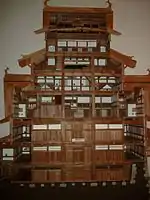Tsuitate
A tsuitate (衝立) is a form of single-panel portable partition traditionally used in Japan since at least the 6th century.[1] They may be made of wood, or a wood frame covered in paper or silk cloth.[1][2] The panels are often illustrated, with paintings on both sides, sometimes by well-known artists.[1] The wood frame may be lacquered,[1][3] and pricier tsuitate may be very richly decorated, including use of precious metals.[3]
Apart from their use as works of art, they are often used to screen entrances, and block wind and sun[2] They may also partition rooms, divide the public part of a shop from the residential area behind, and act as a signboard.[1]
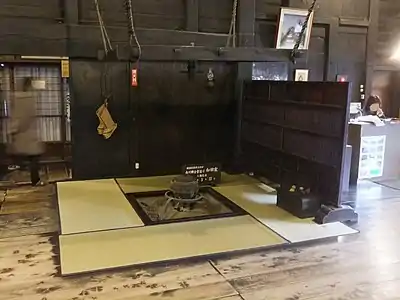 A robust all-wood tsuitate, screening a fire from drafts in a rural house (history exhibit)
A robust all-wood tsuitate, screening a fire from drafts in a rural house (history exhibit)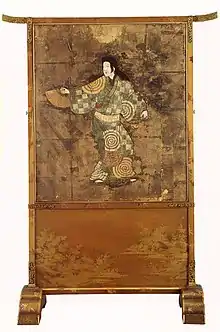 A tall 1700s tsuitate, presumably a replica konmeichi screen.[4]
A tall 1700s tsuitate, presumably a replica konmeichi screen.[4]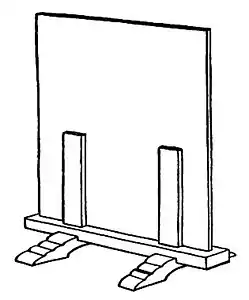 Tsuitate could be made in one piece, or as here, with a separate stand and panel[5]
Tsuitate could be made in one piece, or as here, with a separate stand and panel[5]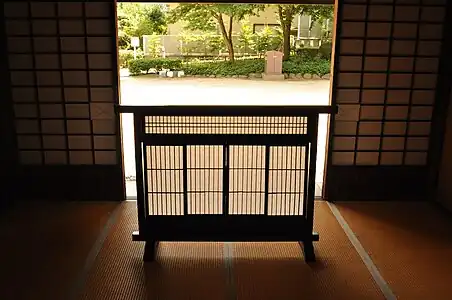 Tsuitate are traditionally used to screen entrances[6]
Tsuitate are traditionally used to screen entrances[6]_of_a_Tiger_-_Kawanabe_Kyosai_-_overall.jpg.webp) A print of a painting by Kawanabe Kyōsai, depicitng a tsuitate screen painted by Kyōsai, complete with his signature on the screen[7]
A print of a painting by Kawanabe Kyōsai, depicitng a tsuitate screen painted by Kyōsai, complete with his signature on the screen[7]
Wikimedia Commons has media related to Tsuitate (standing screen).
References
- Troy Segal. "Beautiful and Functional Japanese Antiques". The Spruce Crafts.
- "Tsuitate shouji 衝立障子". Dictionary of Japanese Architectural and Art Historical Terminology.
- "A Magnificent Large Gold Lacquer Tsuitate [Standing Screen] , MEIJI PERIOD (LATE 19TH CENTURY)". www.christies.com.
- "Konmeichi-no-shouji 昆明池障子". Dictionary of Japanese Architectural and Art Historical Terminology.
- Morse, Edward S. (1885). "3: Interiors". Japanese Homes and their Surroundings. Charles E. Tuttle Company. ISBN 0-8048-0998-4.
- van der Reyden, Dianne Lee. "THE HISTORY, TECHNOLOGY, AND CARE OF FOLDING SCREENS: CASE STUDIES OF THE CONSERVATION TREATMENT OF WESTERN AND ORIENTAL SCREENS" (PDF).
{{cite journal}}: Cite journal requires|journal=(help) - "Standing Screen (Tsuitate) of a Tiger". www.brooklynmuseum.org. Brooklyn Museum.
This article is issued from Wikipedia. The text is licensed under Creative Commons - Attribution - Sharealike. Additional terms may apply for the media files.
